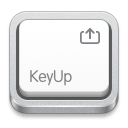
If we want to track user-initiated focus-loss, then we should avoid causing it ourselves. The best recipe is to be careful when using these events. These features sometimes cause focus/blur handlers to misbehave – to trigger when they are not needed. If it is reinserted later, then the focus doesn’t return.

Let’s use them for validation of an input field. The focus event is called on focusing, and blur – when the element loses the focus. We’ll do the best to cover them further on. There are important peculiarities when working with focus events.
#Detect keyup on blur code#
Losing the focus generally means: “the data has been entered”, so we can run the code to check it or even to save it to the server and so on. That’s when a user clicks somewhere else or presses Tab to go to the next form field, or there are other means as well. The moment of losing the focus (“blur”) can be even more important. There’s also an autofocus HTML attribute that puts the focus onto an element by default when a page loads and other means of getting the focus.įocusing on an element generally means: “prepare to accept the data here”, so that’s the moment when we can run the code to initialize the required functionality.

An element receives the focus when the user either clicks on it or uses the Tab key on the keyboard.


 0 kommentar(er)
0 kommentar(er)
